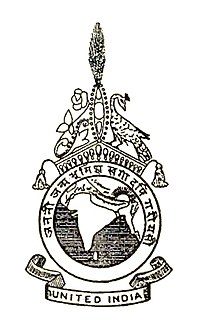 The coat of arms of Anushilan Samiti | |
| Formation | 24 March 1902 |
|---|---|
| Dissolved | 1930s |
| Type | Secret Revolutionary Society |
| Purpose | Indian Independence |
| Location | |
| Anushilan Samiti |
|---|
 |
| Influence |
| Anushilan Samiti |
| Notable events |
| Related topics |
| Part of a series on |
| Political revolution |
|---|
 |
|
|
Anushilan Samiti (Bengali: অনুশীলন সমিতি, lit. 'Practice Association') was an Indian fitness club, which was actually used as an underground society for anti-British revolutionaries.[1] In the first quarter of the 20th century it supported revolutionary violence as the means for ending British rule in India. The organisation arose from a conglomeration of local youth groups and gyms (akhara) in Bengal in 1902. It had two prominent, somewhat independent, arms in East and West Bengal, Dhaka Anushilan Samiti (centred in Dhaka), and the Jugantar group (centred in Calcutta).
From its foundation to its dissolution during the 1930s, the Samiti challenged British rule in India by engaging in militant nationalism, including bombings, assassinations, and politically motivated violence. The Samiti collaborated with other revolutionary organisations in India and abroad. It was led by the nationalists Aurobindo Ghosh and his brother Barindra Ghosh, influenced by philosophies like Italian Nationalism, and the Pan-Asianism of Kakuzo Okakura. Ullaskar Dutta used to be the Jugantor group's principal bomb maker until Hemchandra Quanungo returned from Paris having learned bomb making and explosive chemistry.[2] The Samiti was involved in a number of noted incidents of revolutionary attacks against British interests and administration in India, including early attempts to assassinate British Raj officials. These were followed by the 1912 attempt on the life of the Viceroy of India, led by Rash Behari Bose and Basanta Kumar Biswas,[3] and the Seditious conspiracy during World War I, led by Jatindranath Mukherjee.[4]
The organisation moved away from its philosophy of violence in the 1920s due to the influence of the Indian National Congress and the Gandhian non-violent movement. A section of the group, notably those associated with Sachindranath Sanyal, remained active in the revolutionary movement, founding the Hindustan Republican Association in north India. A number of Congress leaders from Bengal, especially Subhash Chandra Bose, were accused by the British Government of having links with the organisation during this time.
The Samiti's violent and radical philosophy revived in the 1930s, when it was involved in the Kakori conspiracy, the Chittagong armoury raid, and other actions against the colonial administration of British India.
Shortly after its inception, the organisation became the focus of an extensive police and intelligence operation which led to the founding of the Special branch of the Calcutta Police. Notable officers who led the police and intelligence operations against the Samiti at various times included Sir Robert Nathan, Sir Harold Stuart, Sir Charles Stevenson-Moore and Sir Charles Tegart. The threat posed by the activities of the Samiti in Bengal during World War I, along with the threat of a Ghadarite uprising in Punjab, led to the passage of Defence of India Act 1915. These measures enabled the arrest, internment, transportation and execution of a number of revolutionaries linked to the organisation, which crushed the East Bengal Branch. In the aftermath of the war, the Rowlatt committee recommended extending the Defence of India Act (as the Rowlatt Act) to thwart any possible revival of the Samiti in Bengal and the Ghadarite movement in Punjab. After the war, the activities of the party led to the implementation of the Bengal Criminal Law Amendment in the early 1920s, which reinstated the powers of incarceration and detention from the Defence of India Act. However, the Anushilan Samiti gradually disseminated into the Gandhian movement. Some of its members left for the Indian National Congress then led by Subhas Chandra Bose, while others identified more closely with Communism. The Jugantar branch formally dissolved in 1938.
- ^ "Kolkata: Five spots linked to the freedom struggle you must know about". The Indian Express. 15 August 2019. Retrieved 15 March 2022.
- ^ Heehs 1993, p. 116-117.
- ^ Heehs 1993, p. 246.
- ^ Dictionary of Martyrs India's Freedom Struggle (1857-1947). Vol. 4. Indian Council of Historical Research. 2016. p. 179.